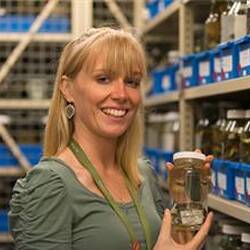Herpetology
The Herpetology Collection was established in the 1850s as part of the general zoology collection. It now contains over 78,000 specimens of snakes, lizards, frogs, salamanders, crocodilians and turtles, and includes over 950 type specimens. The majority of the collection comprises specimens kept in 70% ethanol, but there is also a dry and skeletal collection, mounted specimens, some cleared and stained specimens, a slide collection of blood smears, a collection of cryogenically stored tissue material and a collection of silicon rubber moulds taken from registered specimens for producing long lasting exhibition casts. Reptiles comprise more than half the collection, with the remainder being larval and adult amphibians. The collection contains a comprehensive representation of amphibians and reptiles from south-eastern Australia, as well as material from elsewhere in Australia and overseas. The collection is supported by an X-ray and photographic collection, a sound library of frog calls and also a herpetological library, comprising both recent and historical publications. Additionally, a collection of 3d CT scans of skeletal features is being developed.
Significance
The Herpetology Collection is one of the oldest collections of reptiles and amphibians in Australia. It is the largest existing collection of south-east Australian reptiles and amphibians, containing the world's most comprehensive collection from this region. As the legislated repository for Victorian reptile and amphibian specimens the Herpetology Collection provides information on the composition and distribution of not only Victorian reptiles and amphibians, but on the whole Australian herpetological fauna over the past 150 years. The collection contains specimens from extinct and endangered populations within Australia making it nationally and internationally significant. Recently efforts have been particularly focussed on developing an increasingly important tissue collection for molecular research. The Type Collection has been acquired over the entire life of the Museum and provides the ultimate reference for a significant number of Australian species.





